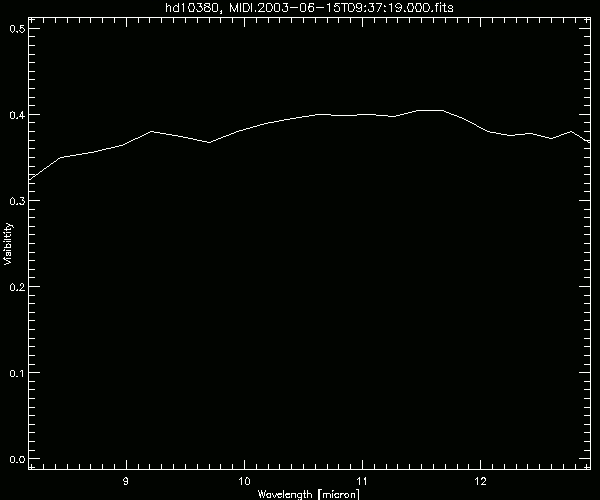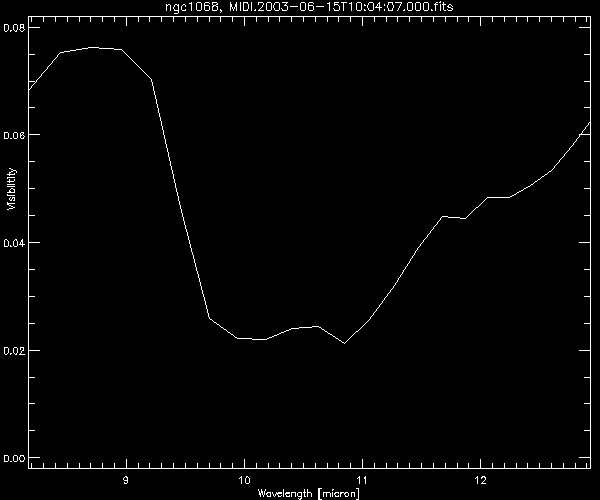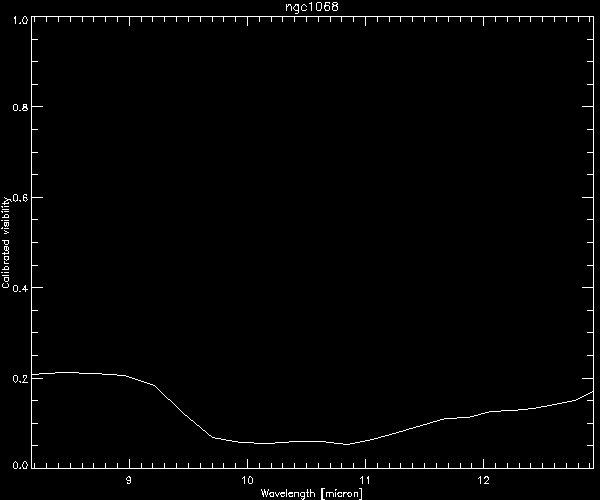
Following the steps described in the previous chapters we will calculate one raw visibility curve for the calibrator HD 10380 and one for the AGN of NGC 1068. Although the thresholds have been determined interactively I set it here with set_thresholds() to get reproducable results. Here it is more important to show the basic steps than getting optimized results. Thus improved visibilities are probably easy to find!
HD 10380

NGC 1068

In a next step we want to determine the instrumental visibility, i.e. the visibility of an unresolved point source, from a calibrator object of known diameter with the routine
insvis = x->instruvisi(diameter,NAME=name)
where diameter is the diameter of the calibrator in mas. If the object is listed in the calibrator database, i.e. in 'heidelberg/calibrators.pro', the diameter can be omitted. The name that is used to find the object in the database is either read from the MIDI data files (can be checked with object = cal->get_objectname()) or can be given with the parameter NAME. The instrumental visibility is calculated by dividing the raw visibility with the expected visibility of the calibrator. When /VISPLOT is specified one gets a plot of the instrumental visibility, i.e. insvis[2,*] vs. insvis[0,*]. The parameter /PLOT launches the display for the wavelength-binned spectral power of the fringes.
HD 10380 is in the database. Thus the output of the command
insvis = cal->instruvisi()
is
Looking up hd10380 in calibrator database Found: 2.85000 mas object: hd10380 Baseline: U1 - U3 ESO's baseline len.: 72.7130 Date of observation: 2003-06-15T09:37:19.000 Local Sid Time: 80914.915 Right Ascension: 25.357838 Declination: 5.4878200 Our baseline length: 72.7233, p.a.: 7.63431 Diameter 2.85000mas = 1.38172e-08rad lambda x_bessel visibility 12.9299 0.244145 0.992568 12.7654 0.247292 0.992375 12.5959 0.250620 0.992169 12.4214 0.254139 0.991948 12.2421 0.257862 0.991711 12.0578 0.261803 0.991457 11.8686 0.265976 0.991183 11.6745 0.270398 0.990888 11.4755 0.275088 0.990571 11.2715 0.280066 0.990227 11.0626 0.285355 0.989856 10.8488 0.290979 0.989454 10.6301 0.296966 0.989017 10.4064 0.303349 0.988541 10.1778 0.310162 0.988023 9.94429 0.317446 0.987456 9.70585 0.325244 0.986835 9.46249 0.333609 0.986152 9.21420 0.342599 0.985400 8.96099 0.352280 0.984567 8.70284 0.362729 0.983643 8.43978 0.374035 0.982614 8.17179 0.386301 0.981462
The last column is the expected visibility of the calibrator and thus the instrumental visibility is close to the raw visibility of HD 10380 (because HD 10380 has a very small diameter and is barely resolved).
To calculate the calibrated visibility of the science object, i.e. to divide the raw visibiliy of the science object by the instrumental visibility, use the routine
calvis = sci->calibratedvisi(cal,diameter,NAME=name,/PLOT,/VISPLOT)
where diameter is the diameter of the calibrator in mas. Alternatively, the diameter can be read from the database ('heidelberg/calibrators.pro') by using the name of the calibrator that is either set automatically from the fits header (can be checked with object = cal->get_objectname()) or manually by using the paramter NAME. The advantage of the routine calibratedvisi() over calling instruvisi() manually and dividing the raw visibility of the science target by the result is the adjustment of the lambda-binning for the visibility of the calibrator, i.e. calibratedvisi() ensures that the same lambda-binning used for the science target is applied to the calibrator. The option /VISPLOT leads to a plot of the calibrated visibility. /PLOT launches the display for the wavelength-binned spectral power of the fringes for both the raw visibility of the science target and the now lambda-bins-adjusted instrumental visibility.
calvis = sci->calibratedvisi(cal,/VISPLOT)
leads to

The wavelength and the calibrated visibility is stored in calvis[0,*] and calvis[2,*].